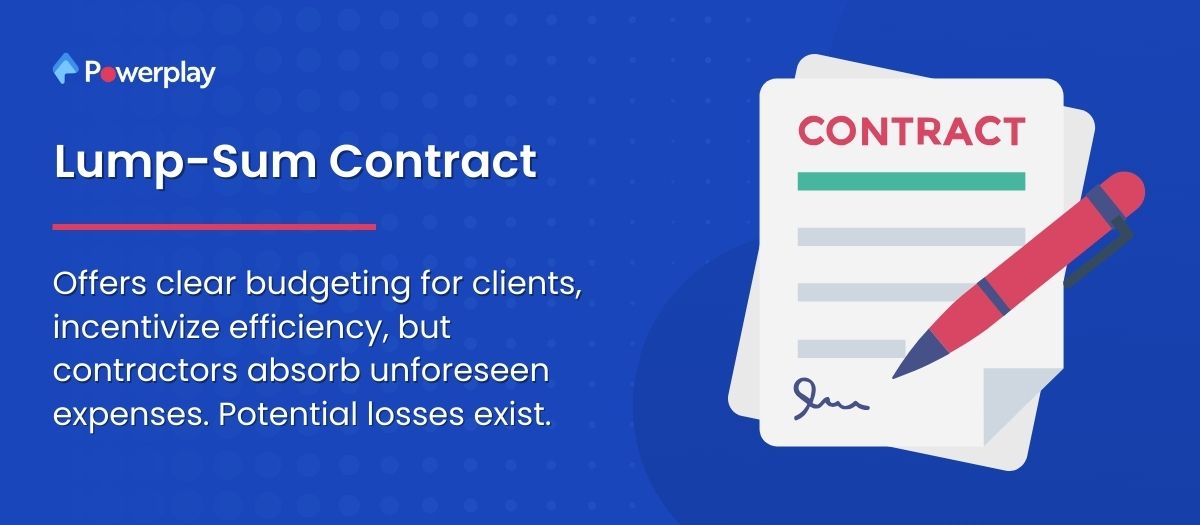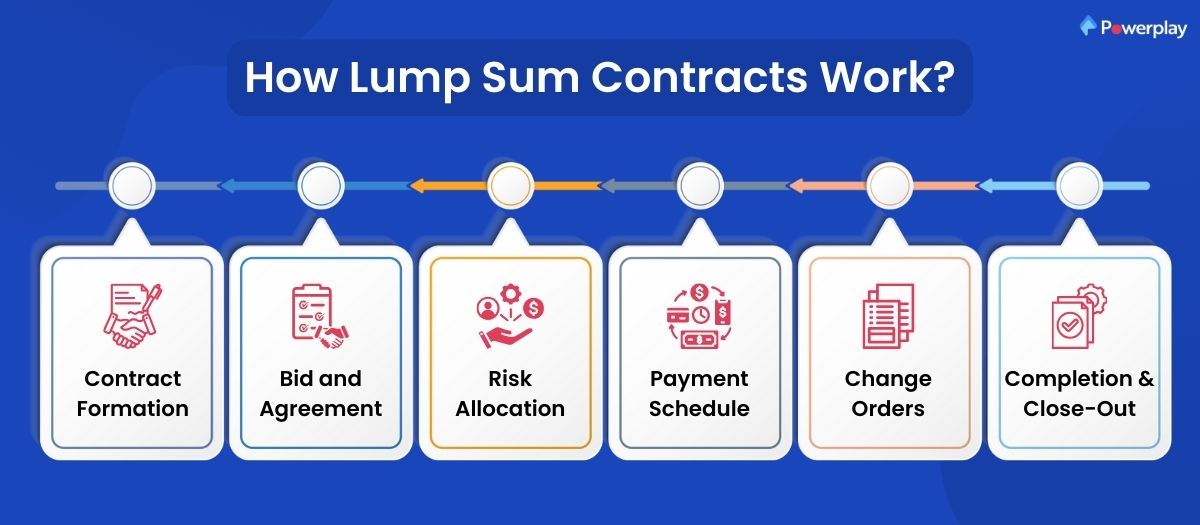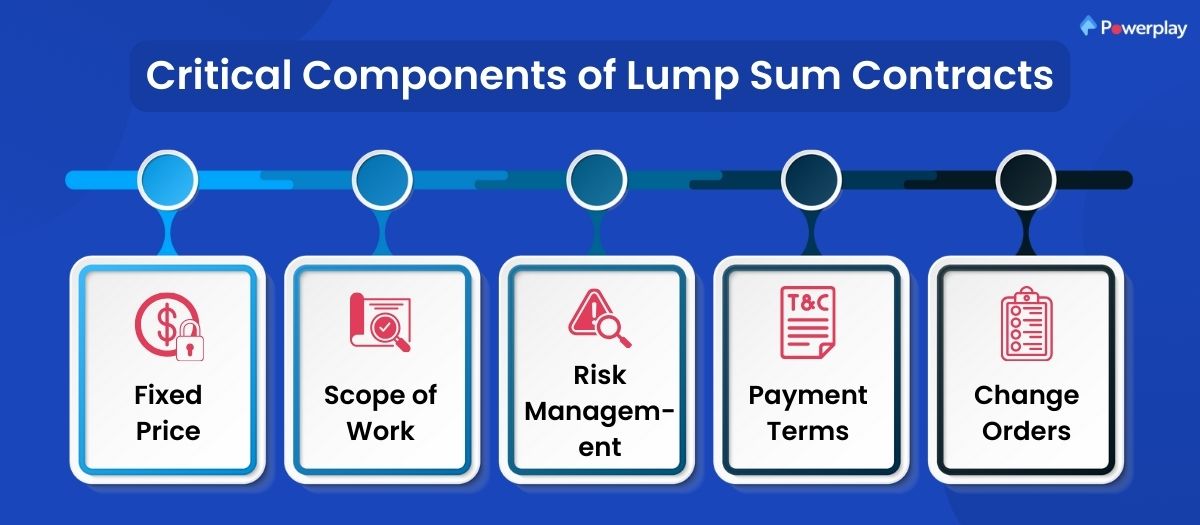Lump Sum Contracts in Construction
-
Sapna
- May 29, 2024

Navigating the difficulties of construction projects requires robust and well-structured agreements. A popular choice among these is the lump sum contract also know as stipulated sum contract. This blog post delves into everything you need to understand about lump sum contracts, including their definition, essential elements, and their pros and cons.

Table of Contents
What Is a Lump Sum Contract?
A lump sum contract, or a fixed-price contract, is a construction contract where the contractor accept to complete the specified project for a set price. This price is fixed and agreed upon before the work begins based on detailed plans and specifications. The contractor assumes the risk of cost overruns but can also benefit from cost savings if the project is completion is under budget.

This contract model simplifies the payment and management process, providing a clear understanding of financial expectations and reducing the administrative burden related to cost tracking. However, it also increases the risk for contractors, as they are responsible for covering any unforeseen costs that exceed the agreed price.
How Lump Sum Contracts Work

Lump sum contracts function by setting a fixed price for all construction-related activities. Here’s how they generally work:
Contract Formation: Initially, a detailed scope of work, specifications, and drawings are prepared. This documentation is crucial as it forms the basis of the contract and outlines clear scope of the expectations and deliverables.
Bid and Agreement: Contractors analyse the project requirements in detail in the above defined scope of work and submit their bids. The winning contractor is bound to complete the specified project at the agreed-upon fixed price, irrespective of actual costs incurred.
Risk Allocation: In lump sum contracts, most risk is moved from the project owner to the contractor. The contractor is responsible for managing costs and ensuring project delivery within the stipulated lump sum agreements, including covering any cost overruns. Conversely, the contractor benefits from the savings if the project completion is under budget.
Payment Schedule: Payments are typically made based on project milestones or on a predetermined schedule, which helps manage cash flow for both the owner and the contractor. Progress payments are common, where the owner pays the contractor at regular intervals (e.g., monthly) based on the work completed.
Change Orders: Modifications to the work or deviations from the initial plans generally require change orders. These are negotiated separately and can lead to an adjustment in the contract price. Change orders are a critical aspect because they need to be managed carefully to avoid disputes and ensure clear communication.
Completion and Close-Out: Upon project completion, the contractor must demonstrate that the work meets all the contractual obligations and quality standards. Final payments are processed after ensuring all aspects of the project are satisfactorily completed.
Critical Components of Lump Sum Contracts

Lump sum contracts are key construction contracts where a single fixed price covers the entire scope of work. Here are the critical components of lump sum contracts:
Fixed Price:
The most definitive feature of a lump sum contract is its fixed price nature. The total project cost is fixed total price agreed upon before the project starts, and this price includes all labour, materials, equipment, and services. This price generally does not change unless modifications to the scope occur through change orders.
Scope of Work:
A clear and detailed scope of work (SOW) is essential for construction agreements. This document specifies what work will be done, details on performance, and requirement of materials and equipment. The clarity of the SOW is crucial as it helps reduce ambiguities and minimise the risk of disputes.
Risk Management:
In lump sum contracts, the contractor assumes the risk for most cost overruns, which can motivate efficiency and cost management. However, this can also encourage the contractor to opt for cheaper materials or methods to protect profit margins, potentially affecting quality.
Payment Terms:
Payments are usually made at predetermined intervals based on the progress of the work or upon reaching specific milestones in project schedule. This structured payment schedule aids in maintaining cash flow for both the contractor and the project owner.
Change Orders:
They are managed contract modifications and are formal agreements that amend the original contract terms, usually to accommodate changes in the work scope, project conditions, or unexpected issues unforeseen circumstances that arise during construction. All involved parties must negotiate and agree upon change orders.
Contractual Documents:
These documents, which form the contract, generally include plans, specifications, and other relevant documentation. They are vital for guiding the execution of the project and serve as a reference in resolving disputes or clarifications.
Advantages of Lump Sum Contracts
Lump sum contracts offer distinctive advantages and disadvantages, catering to the different needs and preferences of project owners and contractors.
Advantages for Project Owners:
- Financial Predictability: Lump sum contracts offer a fixed price, making it easier for owners to budget and plan without concerns about escalating costs.
- Reduced Supervision: Since the contractors are responsible for the execution details, owners need not monitor daily operations or the breakdown of costs, simplifying project management.
- Faster Project Completion: Contractors incentivise to complete the project efficiently to maximise their profit, potentially leading to faster project delivery.
- Simplified Financing: With clear costs and outcomes, these contracts are typically more attractive to lenders and investors, facilitating easier access to financing.
Advantages for Contractors:
- Clear Requirements: All plans and specifications are finalised before work begins, giving contractors a clear directive and reducing complexity and ambiguity.
- Administrative Simplicity: These contracts usually involve less paperwork and lower administrative demands, reducing overhead costs.
- Potential for Higher Profit: If contractors manage to operate under the budget, the savings directly contribute to their profit margin, as they are not required to disclose the cost breakdown.
Disadvantages for Project Owners:
- Less Flexibility: Any changes to the project scope require formal change orders, which can be cumbersome and costly.
- Risk of Lower Quality: To increase profitability, contractors might be tempted to cut corners, possibly affecting the project quality.
Disadvantages for Contractors:
- Financial Risk: Contractors bear the cost of overruns, which can affect their profitability.
- Burdensome Change Processes: Modifications to the contract entail a detailed and often time-consuming change order process.
Lump sum contract template
A lump sum contract template is a formal document that summaries the entire scope of work for a construction project at a fixed price. It clearly details deliverables, timelines indirect costs, and terms to mitigate ambiguities and ensure all parties are aligned on expectations and responsibilities.
This template will also help to ensure your construction project completion is within budget and time. So download now to take advantage of a streamlined, risk-managed approach to your next project!
Construction Contract Types Compared
Lump sum contracts are just one option among several common construction contract types, each catering to different project conditions and risk preferences. Here’s a brief comparison of lump sum contracts compared with other widely used contracts in the construction industry.
Guaranteed Maximum Price (GMP) vs. Lump Sum Contracts
Guaranteed maximum price (GMP) contracts cap the project cost, protecting owners from overruns, with any excess costs absorbed by the contractor. This arrangement offers budget predictability similar to lump sum contracts but places greater risk on contractors who must manage costs meticulously to avoid financial loss.
Cost-Plus Contracts vs. Lump Sum Contracts
In cost-plus contracts, the owner agrees to reimburse the contractor for all project costs plus an agreed-upon profit margin. This setup benefits contractors by ensuring profitability but poses a risk to owners due to potentially unbounded costs, unlike lump sum contracts that cap total expenditures.
Time and Materials (T&M) Contracts vs. Lump Sum Contracts
Time and materials (T&M) contracts are flexible, with owners paying contractors based on actual work done and time and materials contracts used, plus a markup. This contrasts with lump sum contracts based on a fixed price, making T&M suitable for projects where the scope isn’t clearly defined.
Unit Price Contracts vs. Lump Sum Contracts
Unit price contracts break down payment into units of work, providing cost clarity on specific portions of the project. This method is ideal for tasks with repeatable actions, like road paving, and offers more flexibility in adjusting the project scope compared to the fixed scope of the lump sum price contracts.
Variations in Lump Sum Contracts

Variations in lump sum contracts, also known as change orders, are modifications to the work specified in the original contract terms, agreed upon by the parties. These changes can result from several factors, including unforeseen conditions, changes in work scope, design alterations, or statutory requirements.
The main reasons for variations include:
Price Fluctuations and Inflation: Economic changes can affect material and labor costs, or labour rates, leading to adjustments in the contract price.
Provisional Items: These are costs for anticipated work or materials not yet specified in detail, which can lead to adjustments as the project specifications become clearer.
Statutory Changes: Legal or regulatory requirements may necessitate changes in construction practices or materials.
Client-Initiated Changes: The client may request changes that alter the scope or quality of the work, impacting timelines and costs.
Events Requiring Adjustments: Unforeseen events, such as exceptionally adverse weather or other neutral events, can impact project timelines and costs, requiring contractual adjustments to accommodate these changes.
Common Issues With Lump Sum Contracts
Lump sum contracts, while popular in the construction industry for their simplicity and fixed pricing, come with several potential issues that both contractors and project owners should be aware of:
Risk of Cost Overruns:
Contractors bear the primary financial risks as they are responsible for completing the project within the agreed sum, despite any unforeseen expenses or issues that may arise.
Inflexibility:
Once a price is set and the project scope defined, any necessary changes require formal change orders. This process can be cumbersome and time-consuming, often involving extensive paperwork.
Estimation Errors:
Accurate project cost estimation is crucial. Errors in the initial estimates can lead to financial losses for the contractor, as they must absorb additional costs unless otherwise negotiated.
Material and Labor Cost Fluctuations:
Prices for materials and labour can vary unexpectedly. Lump sum contracts typically do not account for these fluctuations, which can impact both owners and the contractor’s bottom line if not properly managed.
Quality Compromises:
There is a risk that contractors might choose lower-quality materials or cut corners to stay within budget, potentially compromising the project’s quality.
Disputes and Claims:
These contracts can lead to disputes over the scope of work, change orders, and contract terms, particularly if there is ambiguity or disagreement over the project details.
Tips for creating lump sum contracts
Here are tips for creating effective lump-sum contracts:
- Clearly define the project scope, including detailed specifications, timelines, and deliverables. This minimises misunderstandings and disputes related to project expectations.
- Accurate cost estimation is crucial. Include contingencies for unforeseen costs to ensure the contract is realistic and manageable for the contractor.
- Specify the process for managing and approving changes to the work scope, including how these changes will affect costs and the project timeline. This will help manage expectations and avoid disputes.
- Define the payment schedule based on milestones or specific time intervals. Ensure all parties understand and agree upon these terms to maintain regular cash flow and financial clarity.
- Maintain open lines of communication between all parties involved. Regularly document progress and any issues that arise and handle them according to the contract’s terms to ensure transparency and accountability.
Lump Sum Contract Construction Example
Imagine a bustling construction site in Hyderabad, India, where the upcoming IT park, “TechNest Hub,” is set to become the new haven for startups and tech giants. The project owner, Rajiv, a seasoned real estate developer, opts for a lump sum contract to ensure the whole project team stays within allocated budget and meets the tight deadline crucial for the upcoming tech boom.
Rajiv signs a lump sum contract with “BuildRight Contractors,” a well-known construction firm with a reputation for timely delivery. The contract stipulates a fixed price of ₹300 crores, including all labour, materials, and other project costs. Rajiv feels secure with this arrangement as it provides a clear financial outline and reduces the administrative burden of monitoring every final cost and detail.
As the project progresses, the contractor faces challenges due to unexpected rock formations during foundation work, necessitating additional excavation and support. However, under the lump sum agreement, “BuildRight Contractors” must handle these unforeseen costs without additional charges to Rajiv. This motivates the contractor to innovate cost-saving measures and optimise resource allocation.
The story of “TechNest Hub” illustrates the typical use of a lump sum contract in Indian construction projects. It showcases its benefits in providing cost certainty and transferring the risk of cost overruns to the contractor, thereby aligning the project’s cost and outcomes with the interests of both the developer and the contractor.
Construction Accounting Software for Lump Sum Construction Contracts
Powerplay is a robust construction accounting software tailored for managing lump sum contracts. It provides precise financial oversight, enabling contractors and project managers to maintain budgets meticulously and avoid unexpected overruns. Its integrated features include detailed expense tracking, budget forecasting, and financial reporting, all designed to uphold the fixed-price nature of lump sum contracts.

Powerplay’s intuitive reports and dashboard allows for real-time financial insights, fostering informed decision-making. By simplifying complex financial data into manageable insights, Powerplay ensures that projects stay within their contractual budget, making it a vital software for successful construction project management.
Conclusion
Lump sum contracts are frequently utilised in the construction industry due to their ability to delineate a fixed price for the complete scope of a project, thus providing a measure of financial stability and clarity. However, while they simplify budget management and risk allocation, these contracts require thorough understanding and strategic management to navigate their inherent challenges and benefits.
Properly executed, a lump sum contract can lead to efficient project execution, but it necessitates meticulous planning, detailed scope definition, and proactive risk management. By carefully negotiating the terms and preparing for unforeseen events, project owners and contractors can leverage lump sum contracts to foster mutual accountability and ensure project success.













